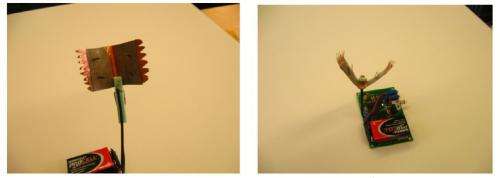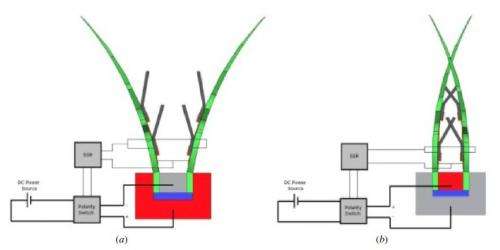October 27, 2011 report
Mechanical engineer creates robot Venus Flytrap

(PhysOrg.com) -- Mohsen Shahinpoor, a professor of mechanical engineering at the University of Maine has created a robot version of the infamous bug eating Venus Flytrap, using a material he invented himself several years ago. Named ionic polymeric metal composite (IPMC), it's a nanomaterial that can be used to mimic muscle function. Shahinpoor describes in his paper published in Bioinspiration & Biomimetics, how he used this material to recreate the sensing and closing abilities of the Venus Flytrap.
To make the robot, Shahinpoor fashioned two “leaves” out of the material he’d created to mimic the mouth-like appearance of the Flytrap. He then created a spine from a roll of copper. Then to copy the tiny hairs on the Flytrap that function as the sensors, he added very small strips of the IMPC material. The rest of the robot was constructed as a normal relay and voltage generation system.
The new material in the robot works in two ways. First, because of the unique properties of the IPMC material, simply touching it causes a very small voltage to be generated. The second is the muscle type flexing or bending, exhibited by the material when given a charge. With the robot, the small strips serve as sensors, that when touched, relay a tiny charge to the voltage generator which sends a little bit bigger charge to the “leaves” causing them to bend inwardly towards one another, or in viewing it, as a mouth closing on its prey.
The material Shahinpoor invented bends when given a charge due to the redistribution of ions.

At first glance, the creation of the robot might not seem like much more than a fun little project for an engineer who likes to tinker. On closer inspection however, it becomes clear that the robot Venus Flytrap is actually a demonstration of a new kind of technology that may lead to advances in medical applications. A refined application, for example, could perhaps one day lead to human muscle replacements or help with sensory applications. One example might be restoring facial expressions to people who lose the ability due to a stroke.
Also, because Shahinpoor’s robot Flytrap has demonstrated an ability to catch flies it’s possible that such technology could also one day be used as a means for allowing robots to feed themselves, thus alleviating the need for a power supply.
More information: Biomimetic robotic Venus flytrap (Dionaea muscipula Ellis) made with ionic polymer metal composites, Mohsen Shahinpoor, 2011 Bioinspir. Biomim. 6 046004. doi:10.1088/1748-3182/6/4/046004
Abstract
The work described in this paper is a novel design of a robotic Venus flytrap (VFT) (Dionaea muscipula Ellis) by means of ionic polymeric metal composite (IPMC) artificial muscles as distributed nanosensors and nanoactuators. Rapid muscular movements in carnivorous plants, such as VFT, which are triggered by antenna-like sensors (trigger hair), present a golden key to study distributed biomolecular motors. Carnivorous plants, such as VFT, possess built-in intelligence (trigger hairs), as a strategy to capture prey, that can be turned on in a controlled manner. In the case of the VFT, the prey that is lured by the sweet nectar in the VFT pair of jaw-like lobes has to flip and move the trigger hairs, which are colorless, bristle-like and pointed. The dynamically moved trigger hairs then electro-elastically send an electric signal to the internal ions in the lobe to migrate outwardly for the jaw-like lobes to close rapidly to capture the prey. The manner in which the VFT lobes bend inward to capture the prey shows a remarkable similarity with typical IPMCs bending in an electric field. Furthermore, the mechano-electrical sensing characteristics of IPMCs also show a remarkable resemblance to mechano-electrical trigger hairs on the lobes of the VFT. The reader is referred to a number of papers in connection with sensing and actuation of IPMCs in particular. Thus, one can integrate IPMC lobes with a common electrode in the middle of one end of the lobes to act like a spine and use IPMC bristles as trigger finger to sense the intrusion of a fly or insect to send a sensing signal to a solid state relay which then triggers the actuation circuit of the IPMC lobes to rapidly bend toward each other and close. The two lobes, which form the trap, are attached to the midrib common electrode which is conveniently termed the spine. The upper surface of each lobe is dished, and spaced along the free margins of the lobes with some 15–20 prong-like teeth. These are tough and pointed, and are inclined at an inward angle so that when the trap is sprung shut they will interlock. We have been experimenting with the VFT closing of its jaw-like lobes that close in about 0.3 s and have gained a lot of knowledge to report on the ionic and electrical mechanisms involved in the operation of such intelligent distributed biomolecular motors.
via Discovery
© 2011 PhysOrg.com




















